Tick Boxes can help you organize your data in various ways. You can use Tick (✓) Boxes to indicate the status of activities in a list. Below, you’ll find 10 useful Tick Box tips and tricks in Google Sheets that I’ve come across. I hope you find them helpful!
The Tick Box in Google Sheets is interactive. When checked, it indicates TRUE, meaning “Yes,” the activity is completed or the answer is correct. By default, it is FALSE.
10 Must-Learn Tick Box Tips and Tricks in Google Sheets
Here are my 10 useful Tick Box tips and tricks in Google Sheets for all the passionate Google Sheets users out there. Some of these tips are explained in detail in my earlier posts. In those cases, I’ll provide a brief description here and include links to the full tutorials in the ‘Resources’ section at the bottom.
1. Insert Tick Boxes in Google Sheets
It’s straightforward. Select the cells where you want to insert Tick Boxes. Then, go to the menu Insert and click on Tick box. That’s all you need to do to insert interactive Tick Boxes.
2. Count Checked and Unchecked Cells
It’s simple. Suppose you have several Tick Boxes in the range A1:A. Use the following COUNTIF formula to count the checked boxes:
=COUNTIF(A1:A, TRUE)Change TRUE to FALSE in this formula to count the unchecked boxes.
3. Conditionally Change the Tick Box Color
From my list of the best Tick Box tips and tricks in Google Sheets, this conditional formatting trick is my favorite.
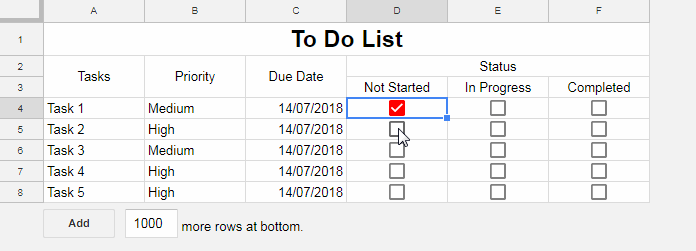
By default, the color of a Tick Box is dark grey. You can change its color easily using conditional formatting.
Although the Tick Box is technically a character, and you can change its color like any font, this method lets you selectively change the color of checked Tick Boxes. Let’s see how to do it:
- Select the cells with the Tick Boxes. For example, select the range
D4:D8. - Go to the menu: Format > Conditional formatting.
- Under Format rules, choose Is equal to and type
TRUE. - In the Formatting style section, choose the font color you want for checked Tick Boxes and set the fill color to None.
Click Done, and the checked Tick Boxes will now appear in your chosen color.
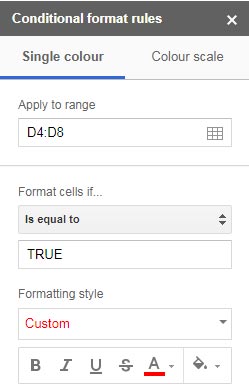
You can apply this method to other ranges, such as E4:E8 or F4:F8, to customize their colors as well.
4. Extract Rows Containing Checked Tick Boxes
If you have a list of student names in column A and Tick Boxes in column B, you can extract rows with checked Tick Boxes using these formulas:
- Using QUERY:
=QUERY(A1:B, "SELECT * WHERE B=TRUE")- Using FILTER:
=FILTER(A1:B, B1:B)5. Create Dynamic Charts by Controlling Chart Data Using Tick Boxes in Google Sheets
This is my second favorite tip among the 10 Tick Box tips and tricks in Google Sheets.
When reporting project status to a client on a weekly, fortnightly, or monthly basis, you can rely on a Combo Chart. Combo charts in Google Sheets are useful for tracking job progress against a schedule.
Understanding the Data
Here’s a sample project schedule showing its progress and completion status. The project was scheduled for 5 weeks but was completed in 6 weeks.
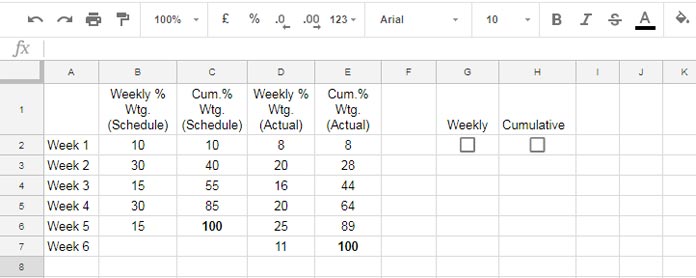
Chart Data Breakdown:
- Column A: Weekly schedule, showing the allowed weeks (5) and the extra week required for completion (6).
- Column B: Total % Weightage of tasks planned, summing up to 100%.
- Column C: Cumulative planned % Weightage.
- Column D: Actual % Weightage of completed tasks.
- Column E: Cumulative actual % Weightage.
What is % Weightage?
The total % Weightage of a project is 100. This value is distributed among individual tasks based on factors like time, manpower, and cost. Each week’s tasks are summed to give the weekly Weightage in Column B, while Column D shows actual completion progress.

The Role of Tick Boxes
Tick Boxes in cells G2 and H2 control the data displayed in the chart. Here’s the formula in cell A10 that dynamically extracts data:
=IF(
AND(G2=TRUE, H2=TRUE), {A1:E7},
IF(
AND(G2=TRUE, H2=FALSE), {A1:B7, D1:D7},
IF(
AND(G2=FALSE, H2=TRUE), {A1:A7, C1:C7, E1:E7}
)
)
)Formula Explanation:
- If both Tick Boxes are checked, the formula extracts the full data range (
A1:E7). - If only the first Tick Box is checked, it extracts weekly data (
A1:B7andD1:D7). - If only the second Tick Box is checked, it extracts cumulative data (
A1:A7,C1:C7, andE1:E7).
Creating a Dynamic Combo Chart with Tick Box Control
To create the chart:
- Select the data range
A10:E16. - Go to Insert > Chart.
- In the Chart editor, configure the following:
- Under Setup Tab:
- Chart type: Combo Chart
- Stacking: None
- Under Customize Tab:
- For series starting with “Cum”:
- Type: Line
- Axis: Right
- For series starting with “Weekly”:
- Type: Column
- Axis: Left
- For series starting with “Cum”:
- Under Setup Tab:
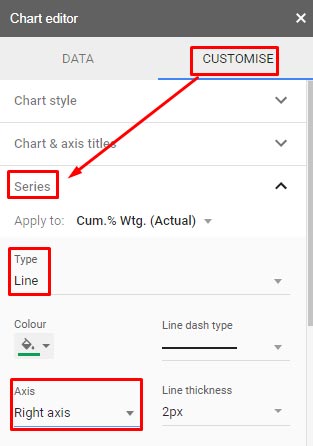
Now your dynamic combo chart is ready! Use the Tick Boxes to control the displayed chart series easily.
6. Retain Tick Boxes with Imported Data
Just like any text, you can copy and paste Tick Boxes into different cells. However, if you use a formula to copy a Tick Box, you won’t get the Tick Box itself. Instead, you’ll only get its value: TRUE (checked) or FALSE (unchecked).
For instance, if you have a Tick Box in cell A1 and reference it in B1 using the formula =A1, cell B1 will display either TRUE or FALSE depending on the state of the Tick Box in A1.
This issue also occurs when you use functions like IMPORTRANGE, FILTER, or QUERY to import or process data containing Tick Boxes.
To overcome this and display a Tick Box-like character instead of TRUE or FALSE, follow these steps:
Example: Creating Custom Tick Box Characters
- Select the range
A1:A10. - Go to Data > Data validation.
- Click Add Rule.
- Under Criteria, select Tick box and check Use custom cell values.
- Enter the following custom characters:
- Unticked:
☐ - Ticked:
☑
- Unticked:
- Click Done.
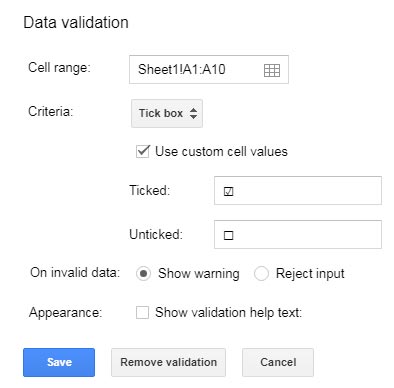
Now, instead of displaying TRUE or FALSE, the formula results will show the custom characters ☐ (for unchecked) and ☑ (for checked).
Alternative Method: You can also select the cells with TRUE/FALSE values and go to Insert > Tick box to reinsert Tick Boxes in the new location.
7. Select or Deselect Multiple Tick Boxes at Once
You can quickly select or deselect multiple Tick Boxes by selecting the range and pressing the spacebar.
8. Use Tick Boxes in To-Do Lists
Here’s how to apply a strike-through effect to mark completed tasks using Tick Boxes in a to-do list.
For example, in the following to-do list, the data range is A4:D8:
- Column A: Tasks
- Column B: Priority
- Column C: Due Date
- Column D: Status (contains Tick Boxes)
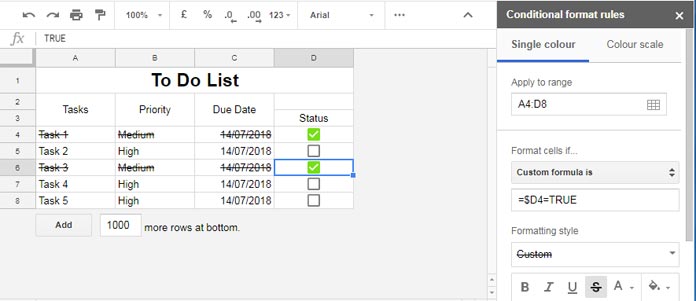
When you tick a box in Column D, you want the corresponding row to be struck through.
Follow these steps:
- Select the range
A4:C8. - Go to Format > Conditional formatting.
- Under Format rules, select Custom formula is.
- Enter the formula:
=$D4=TRUE - Under Formatting style, select Strikethrough and set the Fill color to None.
- Click Done.
Now, when you check a Tick Box in Column D, Google Sheets will automatically strike through the content in the corresponding row (A4:C8).
9. Highlight Rows Based on Tick Box Selection
To highlight a row when a Tick Box is checked, follow the same steps as in the strike-through example.
Instead of selecting Strikethrough under Formatting style, choose a Fill color of your choice.
10. Delete Tick Boxes in Google Sheets
To delete a Tick Box, select the cell and press the Delete key. Alternatively, go to Edit > Delete > Values.
Resources
Here are some related tutorials you might find useful:






















I have a pretty interesting and complex problem with checkboxes – I will do my best to explain. I don’t think there’s a solution, but I’d love to make sure.
On Tab A – Column 1 is “First Name”, Column 2 is “Last Name”, Column 3 is all checkboxes.
On Tab B – In Tab B Column 1, I use an ARRAYFORMULA to combine “First Name” and “Last Name” from Tab A into “Full Name”. In Column 2, I have all checkboxes. The checkboxes in Tab B Column 2 are used to indicate something different than the checkboxes in Tab A Column 3.
Here’s when things break…I go to sort first or last name in Tab A, my Tab A check marks re-sort as intended along with the name, my full names in Tab B re-sort as intended, but my checkmarks in Tab B remain fixed in their previous cells and do not re-sort making my data in Tab B now incorrect.
This is the undesired behavior that I’m hoping to solve.
Hi, Danielle Epstein,
I have a similar tutorial here – Align Imported Data with Manually Entered Data in Google Sheets.
Let’s apply the same logic here to solve your tick box problem.
Solution:
You require a Unique ID column in your table. So that we can keep the data aligned in different tabs. Here is my example sheet.
https://docs.google.com/spreadsheets/d/1IebnZaHI98vGwGQ8BeD1vNDn9dzVoDQ3TSrE0ZhOur8/copy
Tab A:
Column 2 is for “First Name”, Column 3 is for “Last Name”, and Column 4 is for checkboxes. Column 1 is an additional column that contains some unique IDs.
Tab B:
In Column 1, I have copy-pasted all the unique IDs from Tab A, Column 1.
In column 2, I have used a flexible array formula to combine “First Name” and “Last Name” from Tab A Column 2 and 3 into a “Full Name”. Further it keeps aligned to the Unique IDs in column A. For that uses a Vlookup.
Column 3 contains tick boxes.
The column 2 data will always keep its position by aligning to the unique IDs. So if you sort the data in Tab A, it won’t affect the data in Tab B. So you can have different tick boxes in Tab A and Tab B.
Tab C:
It’s for sorting Tab B as per the data in Tab A. It has no other purpose. If you don’t want, you can delete this tab.
I have checkboxes on column B and checkboxes on column D. When cell on column B is checked(true) how to make column D uncheck automatically.
Thank you.
Hi, giovanni,
You can do that as follows.
Assume you have Checkbox in cell B1 and also in cell D1.
In cell D1, enter the below formula (yes! you can overwrite on the existing Checkbox there).
=if(B1=TRUE,FAlSE,TRUE)It has one issue. By default, this formula makes the Tick box in D1 to TRUE. When you uncheck Tick box in B1, the Tick box in D1 will also get unchecked.
Hope this may help.
Looks good so far, I just can´t have D1 always true… I need three stages, to be done(checkbox unchecked D1) done(box checked D1)..then Item sent(checkbox true B1)
Hi, I may need additional information to give you a proper reply.
Is there any other cell involved other than cell B1 and cell D1. If so, we can code the formula using Logical AND/OR.
Like;
=if(and(B1=TRUE,F2="to be done"),FALSE,TRUE)In this cell B1 to be TRUE and F2 must contain the string “to be done”, then only the checkbox in cell D1 will be unchecked (FALSE), else checked (TRUE).
This way you can develop this logical test formula. If you can share an example Sheet, I may able to help.
Useful Link: Combined use of If, AND, OR logical functions.